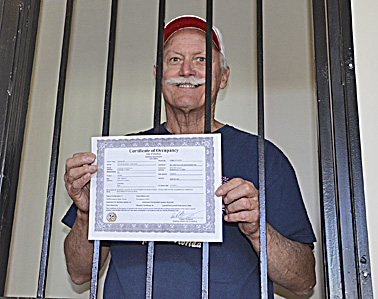HIGH SPRINGS – Santa was escorted by a bright red High Springs fire engine and police vehicles, all with lights flashing and the occasional sound of a siren when crossing a busy intersection. The caravan snaked through back roads and highways to make sure everyone on the list received their Christmas gifts.
Each year, the High Springs Police Department (HSPD) organizes a gift-giving program for people in the community who need help with Christmas gifts. This year, “Operation Holiday Cheer” received gifts throughout the collection period, which began the Monday after Thanksgiving.
Most of the donations of unwrapped children’s gifts showed up about one week before Christmas, said HSPD project organizer Stephanie Hall.
“We were beginning to get a little worried that we would not have enough gifts for all of the people on our list,” she said. Ultimately, not only did the High Springs community step up to help out, but the Live Oak Fire Department also showed up with eight-and-a-half large boxes of toys.
“They collect gifts for 400 kids each year and actually had some items left over after they completed their gift distribution,” Hall said.
On Monday, Dec. 23, a white city truck and a trailer, filled to overflowing with puzzles, games, dolls, clothes and many other requested items, left the HSPD with Santa riding in the front seat. All were bound for 12 area homes. Santa had a list of 38 children to deliver presents to. In addition, restaurant gift cards and other items were delivered to parents as well.
Five children shrieked with delight at one house where Santa handed out bicycles, scooters and other gifts. The bearded, gift-giving gentleman received more than his fair share of hugs from grateful children and their moms for his efforts. In some areas, neighbors came out to see what all the fuss was about.
One family, which had suffered a tragedy this past year, received tickets to an adventure park, along with hotel and food accommodations and a gas card.
At another home, a mother of five had been diagnosed with a medical condition and had numerous surgeries in the past year and a half.
Jeanette Avila, 42, is the mother of four boys, ranging in age from 6 to 15 years old, and one 5-year-old girl. She is a stay-at-home mom and her husband works as a police officer at a local hospital. Between the cost of all the surgeries and her ill health, the Avilas were not able to provide their children with the type of Christmas they would want. This is the second year Operation Holiday Cheer has chosen to help this family with gifts for their children.
“I surprised the kids and did not tell them they were going to get a visit from Santa and all these toys. They were absolutely thrilled,” said Avila, who praised the HSPD and organizer Stephanie Hall for all her work to make this event happen for her children. Bicycles for the older children and scooters for the younger ones were a big hit with her kids.
“They have been racing around the house with the scooters and are just having the time of their lives,” she said.
Hall obtained the list of families who needed help from the High Springs Community School and from the day care owners in High Springs.
“After we received the abundant supply of boxes from Live Oak, we realized we had more than we needed for the original list of families," Hall said. "That’s when we contacted the day care centers in town. We wanted to make sure everyone who needed toys this year had them."
# # #
Email Cwalker@
alachuatoday.com
Add a comment



